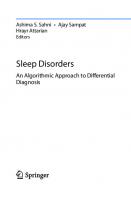Automated Analysis of the Oximetry Signal to Simplify the Diagnosis of Pediatric Sleep Apnea: From Feature-Engineering to Deep-Learning Approaches (Springer Theses) 9783031328312, 9783031328329, 3031328310
This book describes the application of novel signal processing algorithms to improve the diagnostic capability of the bl
107 37 2MB
English Pages 108 [104]
Table of contents :
Supervisors’ Foreword
Foreword by the Bioengineering Group of the Automatic Control Spanish Association (CEA)
Acknowledgements
Contents
Acronyms
1 Introduction
1.1 The Biomedical Signal Processing Framework: Feature-Engineering and Deep Learning
1.2 Pediatric Obstructive Sleep Apnea (OSA)
1.3 Pediatric OSA Diagnosis: Polysomnography (PSG)
1.4 Alternatives to PSG
1.4.1 Overnight Oximetry
1.5 State-of-the-art: Automated Analysis of the Oximetry Signal to Diagnose Pediatric OSA
1.5.1 Conventional Oximetric Indices
1.5.2 Automated Signal Processing Methods
References
2 Hypotheses and Objectives
2.1 Hypotheses
2.2 Objectives
2.3 Thesis Organization
References
3 Methods
3.1 Subjects and Signals Under Study
3.1.1 Childhood Adenotonsillectomy Trial (CHAT) Database
3.1.2 University of Chicago (UofC) Database
3.1.3 Burgos University Hospital (BUH) Database
3.2 Pre-processing
3.3 Feature Engineering
3.3.1 Feature Extraction
3.3.2 Feature Selection
3.3.3 Pattern Recognition
3.4 Deep Learning
3.4.1 Proposed Convolutional Neural Network (CNN) Model
3.4.2 CNN Training and Optimization Process
3.5 Statistical Analysis
3.5.1 Statistical Hypothesis Tests
3.5.2 Diagnostic Performance Metrics
3.5.3 Measures of Agreement
3.5.4 Validation Strategies
References
4 Results
4.1 Application of Novel Feature-Extraction Algorithms
4.1.1 Bispectral Analysis
4.1.2 Wavelet Analysis
4.1.3 Detrended Fluctuation Analysis
4.2 Application of Deep-Learning Techniques
References
5 Discussion
5.1 Novel Features to Provide Relevant and Complementary Information from Oximetry Recordings
5.1.1 Bispectral Analysis
5.1.2 Wavelet Analysis
5.1.3 Detrended Fluctuation Analysis
5.2 A Deep-Learning Based Methodology to Automatically Extract the Relevant Information from Raw Oximetry Recordings
5.3 Comparison of Performance: Feature-Engineering, Deep-Learning, and State-of-the-art
5.3.1 Comparison Between Feature-Engineering and Deep-Learning Approaches
5.3.2 Comparison with State-of-the-art Studies
5.4 Limitations of the Study
References
6 Conclusions
6.1 Contributions
6.2 Main Conclusions
6.3 Future Research Lines
References
Appendix A About the Author
Supervisors’ Foreword
Foreword by the Bioengineering Group of the Automatic Control Spanish Association (CEA)
Acknowledgements
Contents
Acronyms
1 Introduction
1.1 The Biomedical Signal Processing Framework: Feature-Engineering and Deep Learning
1.2 Pediatric Obstructive Sleep Apnea (OSA)
1.3 Pediatric OSA Diagnosis: Polysomnography (PSG)
1.4 Alternatives to PSG
1.4.1 Overnight Oximetry
1.5 State-of-the-art: Automated Analysis of the Oximetry Signal to Diagnose Pediatric OSA
1.5.1 Conventional Oximetric Indices
1.5.2 Automated Signal Processing Methods
References
2 Hypotheses and Objectives
2.1 Hypotheses
2.2 Objectives
2.3 Thesis Organization
References
3 Methods
3.1 Subjects and Signals Under Study
3.1.1 Childhood Adenotonsillectomy Trial (CHAT) Database
3.1.2 University of Chicago (UofC) Database
3.1.3 Burgos University Hospital (BUH) Database
3.2 Pre-processing
3.3 Feature Engineering
3.3.1 Feature Extraction
3.3.2 Feature Selection
3.3.3 Pattern Recognition
3.4 Deep Learning
3.4.1 Proposed Convolutional Neural Network (CNN) Model
3.4.2 CNN Training and Optimization Process
3.5 Statistical Analysis
3.5.1 Statistical Hypothesis Tests
3.5.2 Diagnostic Performance Metrics
3.5.3 Measures of Agreement
3.5.4 Validation Strategies
References
4 Results
4.1 Application of Novel Feature-Extraction Algorithms
4.1.1 Bispectral Analysis
4.1.2 Wavelet Analysis
4.1.3 Detrended Fluctuation Analysis
4.2 Application of Deep-Learning Techniques
References
5 Discussion
5.1 Novel Features to Provide Relevant and Complementary Information from Oximetry Recordings
5.1.1 Bispectral Analysis
5.1.2 Wavelet Analysis
5.1.3 Detrended Fluctuation Analysis
5.2 A Deep-Learning Based Methodology to Automatically Extract the Relevant Information from Raw Oximetry Recordings
5.3 Comparison of Performance: Feature-Engineering, Deep-Learning, and State-of-the-art
5.3.1 Comparison Between Feature-Engineering and Deep-Learning Approaches
5.3.2 Comparison with State-of-the-art Studies
5.4 Limitations of the Study
References
6 Conclusions
6.1 Contributions
6.2 Main Conclusions
6.3 Future Research Lines
References
Appendix A About the Author

- Author / Uploaded
- Fernando Vaquerizo Villar
![Development of Implantable Electronics as Novel Approaches to Obstructive Sleep Apnea [1st ed.]
9789811583261, 9789811583278](https://ebin.pub/img/200x200/development-of-implantable-electronics-as-novel-approaches-to-obstructive-sleep-apnea-1st-ed-9789811583261-9789811583278.jpg)







![A Patient’s Guide to Obstructive Sleep Apnea Syndrome (Moremedia) [1st ed. 2023]
3031382633, 9783031382635](https://ebin.pub/img/200x200/a-patients-guide-to-obstructive-sleep-apnea-syndrome-moremedia-1st-ed-2023-3031382633-9783031382635.jpg)
